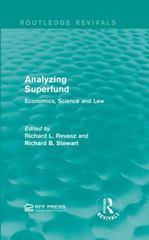Question
HH The problems are provided below. tt the question is okay plz Problem 1. Radish farmer's cost function is given as follows: CR = R
HH The problems are provided below. tt the question is okay plz
Problem 1.
Radish farmer's cost function is given as follows:
CR = R 2 + 8 (1)
Fishing company's cost function is expressed as follows:
CT (R, T) = T 2 + T R + 4 (2)
Suppose the prices for radish and fishing trip are PR = 11, PT = 10. 1.1. Derive farmer's and fishing company's marginal cost function.
1.2. Suppose the farmer and fishing company merged. Write down the profit maximization problem of the merged firm, and solve the efficient allocation (i.e. efficient radish(R), fishing trip(T) and the profit of the merged firm). From now, we assume the farmer and fishing company cannot be merged.
1.3. Suppose the property right (i.e. right to emit pollutants from fertilizer) is not clearly assigned to anyone. Write down the profit maximization problem of the farmer and fishing company, and solve each firm's profits (?R, ?T ) and the levels of production (R, T). Compare the each firm's profit with the profit of the merged firm.
1.4. Now, we assume that the property rights are assigned to the fishing company (victim). Find the profits of the fishing company and the farmer, and the production of the radish(R) and fishing trip (T).
1.5. Now, we assume that the property rights are assigned to the farmer (polluter). Find the profits of the fishing company and the farmer, and the production of the radish(R) and fishing trip (T).
1.6. Describe the Coase theorem with the results of 1.1 to 1.5.
Consider now the non-trivial case (?) 1(p, w). Rewrite (-p)-(=(, ) - (p?)) = p. (1(P?)-(p,w))-p-(x(P, w')-1(p,w)). Consider separately each term of the right-hand side. Derive the signs of each of the two terms using (some) assumptions of the proposition and the fact that we assumed '-p-rp.) for the compensated law of demand. To derive the sign of the second term of the right-hand side you will need to make use of the weak axiom of revealed preference. 3. Put everything together to conclude the proof of the first direction. c.) Given the characterization of the compensated law of demand by the weak axiom of revealed preference, you need to explain to your grandmother the meaning of the weak axiom of revealed preference. Provide a verbal interpretation of the weak axiom of revealed preference. d.) The weak axiom of revealed preference may be viewed as a condition on the "consistency of consumer choice. We may be inclined to label a consumer violating this condition as being irrational (unless a more complex setting is considered). So the above proposition characterizes the compensated law of demand in terms of consistency of consumer choice. But is it really a characterization in terms of rational consumer choice in the sense of having complete and transitive preferences over consumption bundles? That is, is the following conjecture true? Conjecture: Suppose that the Walranian demand function r(p, w) is homogeneous of degree zero and satufes Walras law. Then zip, w) satisfies the compensated law of demand if and only if the consumer has complete and transitive preferences over consumption bundles Consider both directions of the conjecture separately. Moreover, consider the special case of L2 separately. [You don't have to present a detailed proof You can make use of results learned in class. The line of arguments should be clear)



Step by Step Solution
There are 3 Steps involved in it
Step: 1

Get Instant Access to Expert-Tailored Solutions
See step-by-step solutions with expert insights and AI powered tools for academic success
Step: 2

Step: 3

Ace Your Homework with AI
Get the answers you need in no time with our AI-driven, step-by-step assistance
Get Started


